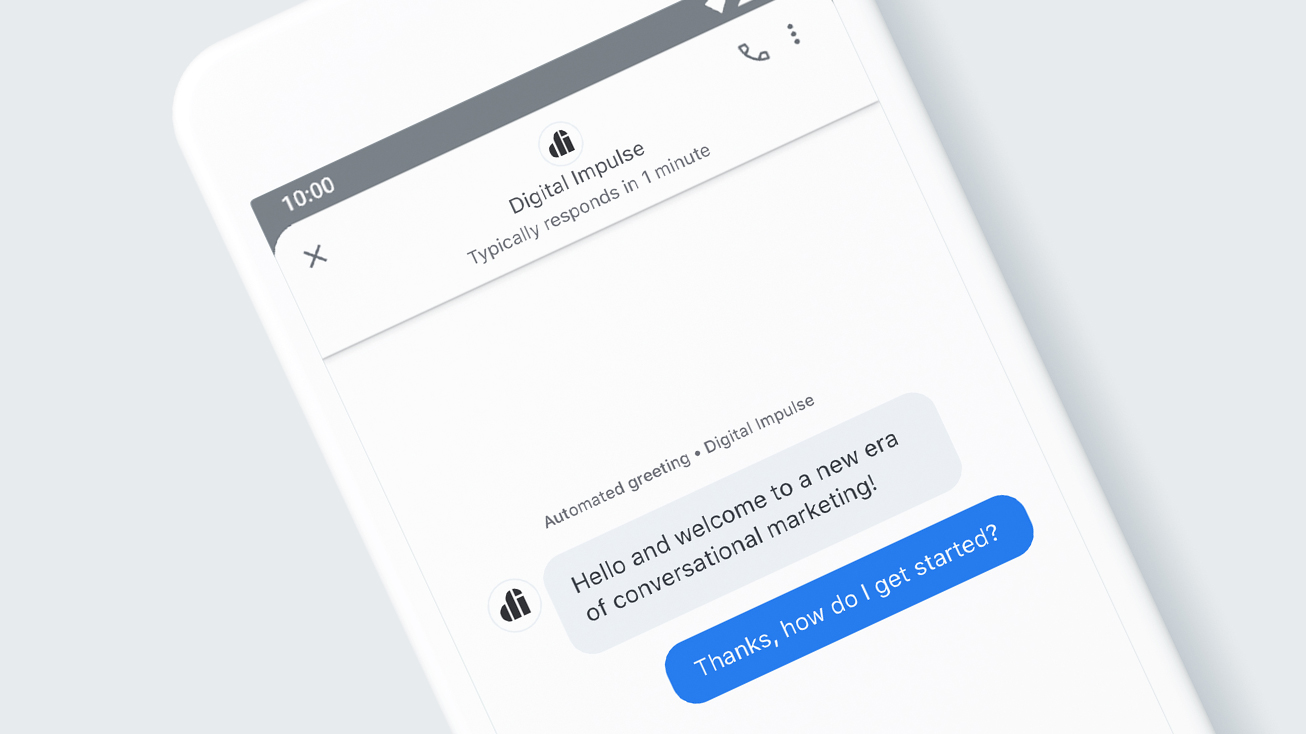“Meet customers where they are.”
With this simple, five-word tagline, Google Business Messages has opened up a world of opportunities for lead capture and nurturing—leads that could have slipped through your fingers simply because they didn’t click on your company’s URL, now readily accessible on the world’s most popular website.
Organizations of all sizes can now empower their customers to initiate a dialogue with them directly from the search results page, including maps. Any question they ask related to your business can be conveniently parlayed into a live conversation.
Business Messages’ Impact on Marketing
From an inbound marketing perspective especially, Business Messages gives firms unprecedented access to potential customers at the earliest stage of the buyer’s journey: discovery and awareness.
This is the point at which customers have identified a problem that needs solving or a desire that needs satiating, but they haven’t found a product or service to fix their problem or quench their craving. In other words, they know what they want, they just don’t know who they want in from.
In the past, businesses would leverage SEO and paid advertising strategies to position themselves front and center during this crucial discovery stage. Now, on top of the above-mentioned strategies, businesses can also chat in real-time with customers, answering their questions and enkindling their interest before they’ve even clicked on a link.
This is the fundamental impact of Business Messages for marketers. Seamlessly transitioning Google search queries into customer service conversations. Instead of waiting for users to stumble upon their company’s landing page during their research, this SERP chat feature allows managers to engage with leads off-site, which lays the path toward an on-site engagement or conversion.
What Marketers Need to Know About Google Business Messages
The platform was initially launched as a mobile app for Google Android devices, but this strictly hand-held interface was limiting for many business owners, so they were slow to adopt it.
Then, in 2021, Google expanded Business Messages to be available to managers on all devices, including desktops and Apple products. Customers would still access the chat feature from their smartphones, but companies could monitor the conversation from their work computers or tablets.
With this subtle but important cross-device barrier removed, more entrepreneurs and department heads started using Business Messages. And it’s easy to see why. It’s a free marketing tool that improves SEO, boosts customer satisfaction, and builds loyalty.
All customers have to do is search for a business, and if the Messages feature is activated, they can open up a dialogue right there in their browser.
This increased availability means organizations can strengthen relationships with the people living in cities where their stores have a strong local presence.
How can I get my team started on Google Business Messages?
To get started, you’ll have to set up a Google Business Profile. You can do that by visiting this page. Getting listed on Google is a good idea anyway if you have physical, brick-and-mortar locations that you want to be included in search results. For example, when someone searches “coffee shops in my area,” Google Business is how your store shows up.
Once you’ve set up your store’s profile, all you have to do is turn on the chat function. You can customize a welcome message but be sure to have notifications turned on, so customers aren’t left hanging. In fact, if a brand doesn’t respond to a customer message within 24 hours, Google will hide the Messages icon from their business profile.
This focus on prompt and consistent service incentivizes organizations who commit to Business Messages to deliver their full attention to their customers.
Using third-party APIs, you can also integrate the Business Messages functionality right onto your website. Or you can integrate Messages into platforms like Hootsuite and HubSpot so you can manage your chats alongside other social media platforms.
What Business Messages Says about Today’s Consumers
For years, dialogue-driven features such as chatbots have helped users make more informed buying decisions. In 2019, Avochato reported that 72% of customers surveyed said that they would make a purchase online if they could ask questions in real-time.
However, to put things lightly, a lot has happened since 2019. The world has changed. And as a result, consumers’ needs and expectations have changed as well.
The prevalence of asynchronous communication has risen immensely during the past two years. Speaking to a friend or coworker who isn’t in the same room as you has become second nature to the point that in-person conversations are almost a novelty.
Because of this shift in the way that we communicate, customers have grown to expect businesses to be available via instant messaging features such as Facebook Messenger and even Instagram DMs. This increased comfort and adeptness with virtual meetings has conditioned us to count on constant contact any time anywhere. We need the people in our lives to be available and reachable via desktop and mobile apps, and businesses are no exception.
Customers today put a ton of pressure on brands to be responsive right when they need help—and to be active in the places users are most comfortable. If it takes off as other Google features have, Business Messages might become one of your most valuable methods of creating those contact points with your audiences.
It’s no longer enough for organizations to rely on users coming to their websites to initiate a dialogue with their brand. Now, you need to go to them (virtually) in person and meet them on common ground.
Thankfully, apps like Google Business Messages enable you to do just that.
How Major Brands are Making Waves with Google Business Messages.
It’s hard to overstate how powerful this tool can be. And yet, with great power comes great responsibility. In this case, increased opportunities to boost user satisfaction mean more time and energy spent pursuing those opportunities. Because if you don’t, one of your competitors will.
As a result, more human resources will have to be dedicated to answering customer questions and providing information. This isn’t a bad thing by any means, but it won’t be effortless.
Luckily, for many companies, the payoff of activating Business Messages is already proving to be worth the investment. This case study from Levi Strauss is just one powerful example of how this tool can strengthen a firm’s relationship with its customers.
Rico Arrastia, Levi’s VP of Product Experience said, “Business Messages creates a stronger customer experience by enabling us to do a better job at ‘hearing’ shoppers, answering their questions, and uncovering new ways to delight Levi’s fans.” For customers, the ability to ask a question and receive a genuine response is part of what makes Business Messages so attractive. For businesses, boosting customer satisfaction scores is always worthwhile.
Let Us Help You Help Your Customers
As a digital agency, innovations like these excite us because they open the door to a world of intriguing possibilities. We find that advancements in marketing tools are almost always made in response to changing consumer needs. Today, it seems that users want more on-demand human connection, and the Business Messages platform reflects that.
Expanding their reach beyond landing pages and onto SERPs allows firms like yours to increase lead capture, improve customer service, and better leverage local SEO. So, if your business is curious about conversational marketing or wants help integrating Business Messages into your tech stack, we encourage you to contact us today. Our team of marketing technologists would be more than happy to help.





